UPSC Daily Current Affairs- 14th October 2023 | Current Affairs & Hindu Analysis: Daily, Weekly & Monthly PDF Download
GS-I
Holodomor
Subject: History
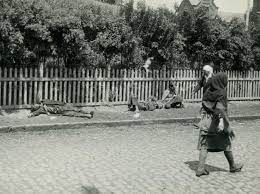
Why in the News?
The Parliamentary Assembly of the Council of Europe recently voted to recognize ‘Holodomor’ as a "genocide."
About Holodomor:
- It is a man-made famine that occurred in the Soviet republic of Ukraine from 1932 to 1933, peaking in the late spring of 1933.
- It left an estimated 3.9 million people dead.
- The primary victims of the Holodomor (literally "death inflicted by starvation") were rural farmers and villagers, who made up roughly 80 per cent of Ukraine's population in the 1930s.
- It was part of a broader Soviet famine (1931–34) that also caused mass starvation in the grain-growing regions of Soviet Russia and Kazakhstan.
- In 2006, by the Law of Ukraine “On the Holodomor of 1932-1933 in Ukraine”, the Holodomor was recognized as genocide of the Ukrainian nation.
- Causes:
- The origins of the famine lay in the decision by Soviet leader Joseph Stalin to collectivize agriculture in 1929.
- Teams of Communist Party agitators forced peasants to relinquish their land, personal property and sometimes housing to collective farms, and they deported so-called kulaks—wealthier peasants—as well as any peasants who resisted collectivization altogether.
- Collectivization led to a drop in production, the disorganization of the rural economy, and food shortages.
- It also sparked a series of peasant rebellions, including armed uprisings, in some parts of Ukraine.
- In 1932, the Communist Party set impossibly high quotas for the amount of grain Ukrainian villages were required to contribute to the Soviet state.
- When the villages were not able to meet the quotas, authorities intensified the requisition campaign, confiscating even the seed set aside for planting.
- Farms, villages, and whole towns in Ukraine were placed on blacklists and prevented from receiving food.
- Peasants were forbidden to leave the Ukrainian republic in search of food.
- In some cases, soldiers were posted in watchtowers to prevent people from taking any of the harvest. Millions starved as the USSR sold crops from Ukraine abroad.
Source: The Hindu
Gunji Village
Subject: Geography
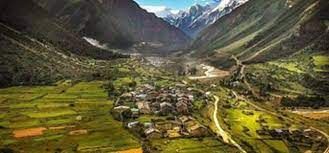
Why in the News?
The Prime Minister‘s recent visit to Gunji, near Kalapani, Uttarakhand, has triggered an uproar in Nepal.
About Gunji Village:
- Location:
- It is located in Dharchula tehsil of Pithoragarh district in northern Uttarakhand.
- It is situated near the borders of Tibet and Neal and the confluence of the Kuthi Yankti and Kalapani Rivers, on the east end of the Kuthi Valley.
- The geographical area of Gunji village is 188.9 hectares.
- Altitude: 3500 meters
- It overlooks Mount Api in Nepal.
- The people residing here are seasonal migrants. With winters coming, people migrate to lower places (mostly to Dharchula) in the same district.
- As per the 2011 census, the village of Gunji has a population of 335 people living in 194 households.
- Gunji village is administered by the Sarpanch (Head of the Village) who is elected representative of the village.
- The village is on the traditional Indian/Nepalese route to Kailas–Manasarovar.
- To visit Gunji, one has to obtain an Inner Line permit.
What is an Inner line permit (ILP)?
- ILP is an official travel document issued by the Government of India to allow inward travel of an Indian citizen into a protected area for a limited period.
- It is obligatory for Indian citizens from outside those states to obtain a permit to enter the protected state.
- The document is an effort by the government to regulate movement to certain areas located near the international border of India.
- This is an offshoot of the Bengal Eastern Frontier Regulations, 1873, which protected the Crown’s interest in the tea, oil and elephant trade by prohibiting “British subjects” from entering into these “Protected Areas”.
- The word “British subjects” was replaced by Citizen of India in 1950.
- There are different kinds of ILPs, one for tourists and others for people who intend to stay for long-term periods, often for employment purposes.
Source: Indian Express
GS-II
United Nations Security Council (UNSC) reforms
Subject: International Relations
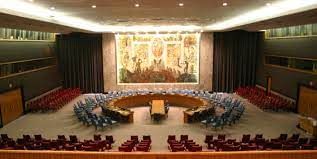
Why in the News?
The longstanding debate on fundamental reforms at the United Nations (UN) has resurfaced once again, more than thirty years after it first began.
About the United Nations Security Council (UNSC):
- It is one of the UN’s six main organs and is aimed at maintaining international peace and security.
- EST: 1945
- HQ: New York City.
- Membership: The Council is composed of 15 Members including 10 non-permanent members.
- P5 with veto power: China, France, Russia, the United Kingdom and the United States.
UNSC elections:
- Each year the General Assembly elects five non-permanent members (out of 10 in total) for a two-year term.
- The 10 non-permanent seats are distributed on a regional basis as follows:
- Five for African and Asian States.
- One for the Eastern European States.
- Two for the Latin American and Caribbean States;
- Two for Western European and other States
- To be elected to the Council, candidate countries need a two-thirds majority of ballots of the Member States that are present and voting in the Assembly.
- The UNSC elections were traditionally held in the General Assembly hall with each of the 193 member states casting its vote in a secret ballot.
Need for United Nations Reforms:
- Inadequate Council Representation: Presently, with 193 UN member-states, only 15 Council members exist, accounting for less than 8%.
- Consequently, a significant number of nations do not feel fairly represented within the Council.
- Imbalanced Powers and privileges: The current privilege enjoyed by the five permanent members and based on historical precedence is politically untenable.
- Europe, comprising just 5% of the global population, controls 33% of Council seats, not including Russia, another European power.
- Financial Disparities: Some countries contribute more financially to the UN than four of the five permanent members.
- For example, Japan and Germany have consistently ranked as the second and third-largest UN budget contributors.
- Unresolved conflicts: Conflicts in regions like Sudan, Syria, Afghanistan, Palestine and Myanmar often remain unaddressed, allowing certain countries and non-state actors to exploit these situations economically.
- Failure in basic functions: The Security Council struggles to fulfil its fundamental role, especially when a permanent member attacks its neighbour.
- For example, when Russia attacked Ukraine in February 2022, its veto power obstructed UNSC resolutions addressing the situation.
- Denied Opportunities for Contributions and Representation: Prominent nations like India, with significant population, economic influence, and substantial contributions to the UN, find their opportunities curtailed.
- Despite their active roles in shaping global affairs, these states remain underrepresented, highlighting the pressing need for reforms within the UN framework.
Way Forward: Suggestive measures
- Expansion of UNSC: The changing needs of global governance for peace and security require significant reforms in the UNSC, including expanding its permanent and non-permanent seats to better address the complex and evolving challenges to international peace and security.
- Democratization: The power imbalance between the P5 and other countries in the UNSC needs to be addressed urgently to make the council more democratic and increase its legitimacy in governing international peace, security and order.
- Equitable Representation: Equitable representation of all the regions in the UNSC is critical to decentralizing its governing power and authority over nations.
- The decentralization of the UNSC’s decision-making processes will enable its transformation into a more representative, participatory body.
- India and UNSC: India as the current one of the non-permanent members of the UNSC can start by drafting a resolution containing a comprehensive set of proposals for reforming the UNSC.
- India urged for UNSC reform hosting a meeting of two separate groupings G-4 and L-69 in New York on the sidelines of the UN General Assembly in September 2022.
Source: The Hindu
Abortion Rights in India: Legal Complexities and Ethical Dilemmas
Subject: Polity
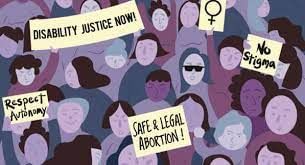
Why in the News?
CJI DY Chandrachud said that India’s abortion law was liberal, pro-choice and far ahead of other countries.
- SC is hearing the case of a married woman who wants to medically terminate her 26-week pregnancy.
- This raises critical questions about a woman’s autonomy in deciding to abort and the existing legislative framework.
Woman’s Perspective
- Unplanned Pregnancy: A 27-year-old married woman, already a mother of two, contends that her pregnancy was unplanned.
- Financial Strain: She argues that her family’s income is inadequate to support another child, and she is undergoing treatment for postpartum depression after her second child’s birth.
Court Decisions and AIIMS Report
- Initial Approval: A two-judge Bench initially allowed the termination, reasoning that an unplanned pregnancy due to contraceptive failure is akin to a forced pregnancy, permitting abortion up to 24 weeks.
- AIIMS Concern: AIIMS, Delhi, raised questions about whether foeticide (stopping the foetal heart) could be performed before termination since the foetus is currently viable.
- Three-Judge Bench: The case was transferred to a three-judge Bench, led by Chief Justice of India (CJI) D Y Chandrachud, which called for a fresh medical report to assess the foetus’s health and the woman’s medical condition.
Understanding the Abortion Law
- Medical Termination of Pregnancy Act (MTP Act): The MTP Act allows the termination of pregnancy in three stages.
- Termination up to 20 weeks with the advice of one doctor.
- Pregnancy at 20-24 weeks requires the opinion of two registered medical practitioners, under specific conditions.
- After 24 weeks, a medical board in approved facilities assesses the termination based on substantial foetal abnormalities.
Court’s History of Allowing Late-Term Abortion
- Several Precedents: The court has previously permitted terminations beyond 26 weeks in various cases, often in cases of rape or consensual relationships.
- Marital Status Factor: The current case distinguishes itself by the woman’s marital status, implying that the conception is consensual and not a forced pregnancy.
Balancing Rights: Woman vs. Unborn Child
- Ongoing Debate: The CJI-led Bench oscillates between prioritizing a woman’s rights over abortion and the need to balance the rights of the unborn child.
- Liberal Approach: India’s law on abortion is considered liberal and pro-choice, with courts often favouring the woman’s autonomy.
Comparisons with International Standards
- Foetal Viability: The concept of “foetal viability” as a benchmark for abortion approval is relatively new in India. It aligns with international standards.
- US Roe v Wade: The landmark 1973 US Supreme Court case, Roe v Wade, allowed abortion until foetal viability. In 1973, viability was at 28 weeks, now lower due to scientific advancements.
- Criticism of Indian Law: Some critics argue that India’s law lacks clarity as the decision to terminate after 20 weeks falls on doctors rather than women, leading to frequent court interventions.
Autonomy vs. Unborn Child’s Rights
- Legislative Gap: While the Indian legal framework supports a woman’s autonomy in reproductive decisions, gaps persist, especially concerning last-minute interventions.
- Ethical Debate: The Indian law leans toward women’s autonomy, but ethical dilemmas arise regarding the rights of the unborn child.
- Legal Precedents: Cases like Nand Kishore Sharma versus Union of India have debated the constitutionality of the MTP Act concerning the right to life of an unborn child.
Conclusion
- The ongoing Supreme Court case highlights the intricate legal and ethical considerations surrounding abortion in India.
- While the law supports a woman’s right to choose, the challenge lies in finding a delicate balance between individual autonomy and the rights of the unborn child.
- As the court grapples with this complex case, it underscores the need for continued legal discourse and potential legislative amendments to address evolving reproductive rights issues.
Source: The Hindu
India and Maldives ties
Subject: International Relations
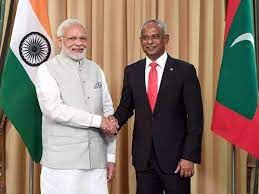
Why in the News?
Recent changes in the Maldives’ leadership have raised questions about the future of its relationship with India.
Central idea
- While leadership changes may bring some alterations, the fundamental ties between the two nations remain intact. From the era of Maumoon Abdul Gayoom to the present day, India and the Maldives have maintained a close and friendly relationship, with occasional challenges. Therefore, it’s essential not to rush to judgment regarding the current situation.
Background
- Historical Ties: The relationship between India and the Maldives is deep-rooted. From Maumoon Abdul Gayoom’s leadership until today, both nations have maintained a close bond, despite occasional hiccups.
- Geographical Proximity: The Maldives spans 90,000 sq km, mostly covered by the sea, with the remaining land spread across 1,200 islands. Situated just 70 nautical miles away, India has always been the Maldives’ closest ally. As Ibn Khaldun stated, geography is destiny.
Challenges in the Maldives
“Maldives, despite its 98% literacy rate, faces various contradictions that pose challenges to democratic governance.”
- Constitutional Restrictions: The Maldivian constitution bars anyone who isn’t a Sunni Muslim from becoming a citizen. This can be seen as restrictive and exclusive, which may not align with broader principles of democratic governance.
- Nascent Civil Society: The civil society in the Maldives is still emerging. This means the public structures and mechanisms that can hold the government accountable and ensure the active participation of citizens in the governance process might be underdeveloped.
- Drug Abuse: The Maldives has been grappling with an increasing problem of drug abuse, which poses social and health-related challenges.
- Distorted Labor Market: This implies there might be imbalances in employment opportunities, perhaps with certain sectors having too many workers and others having too few, or challenges related to wages and workers’ rights.
- Growing Inequality: Despite its successes in areas like tourism, the Maldives faces growing economic disparities among its population.
- Foreign Influence and Debt: China’s policy of extending debt and subsequently interfering in the internal politics of the Maldives, as well as supporting conservative elements, poses challenges. This not only can lead to a debt crisis but also threatens the democratic progression of the country.
- Legacy of Controlled Regime: The influence of the Gayoom years and the alignment with China by certain elements for narrow gains might not serve the broader interests of the Maldivian nation in the long term.
India’s Role
- Historically: From Buddhism’s prevalence in the Maldives to its dependence on India during the British protectorate era (1887–1965), India has always played an influential role.
- Economically: The State Bank of India has been instrumental in boosting the Maldives’ tourism economy and remains the largest bank there.
- Assistance: Whether during the 1988 coup, the 2004 tsunami, or the 2014 water crisis, India has always been the first to assist. India also supplies essential items in bulk and contributes significantly to the Maldivian education and health sectors.
- Defence and Security: India has been a robust defence partner, conducting joint exercises and providing security assistance.
India’s Concerns Regarding the Maldives
- China’s Growing Influence: China’s increasing role in the Maldives is driven by debt financing. This kind of influence, particularly through debt traps, could lead to the consequent hegemony of China in the region, which is a matter of concern for India given the strategic importance of the Indian Ocean Region.
- Internal Interference by External Powers: China’s policy of interfering in the internal politics of the Maldives, especially its support for conservative elements, is worrisome for India. This could hinder the development of a robust democracy in the Maldives and potentially impact the bilateral relationship between India and the Maldives.
- Economic Interests: With projects like greater Male connectivity and being a major supplier of essential goods to the Maldives, India has vested economic interests. Any disruption or potential shift in trade relations can impact India’s economic engagement.
- Security and Defense Cooperation: Defence cooperation isn’t just about tangible assets like helicopters but extends to joint exercises, training, and disaster management. Any shift in Maldivian policies that affects this cooperation can be concerning.
- Legacy of Assistance: India’s role as a primary responder to Maldivian crises and its consistent support over the years hold significance. India would be concerned if such efforts and goodwill weren’t recognized or undermined by external influences.
Recent developments in the Maldives
- President Designate Mohamed Muizzu: Mohamed Muizzu, described as a Western-educated engineer, is expected to take over the reins of leadership. His past roles and his education may influence the Maldives’ direction, both domestically and in terms of foreign relations.
- Former President Yameen’s Situation: Yameen’s shift from jail to house arrest indicates changing political dynamics within the Maldives. Given that Yameen’s tenure was marked by a pro-China policy, any change related to his influence might hint at a shift in foreign policy alignment.
Conclusion
- India’s unwavering commitment has significantly shaped the Maldives, and any impulsive decisions could be detrimental to the latter. Given the deep historical ties and mutual interests, the new leadership must recognize and value the long-standing bond. As history has often shown, taking relationships for granted can have grave consequences.
Source: Indian Express
GS-III
The G20 Roadmap on Crypto Assets
Subject: Economy
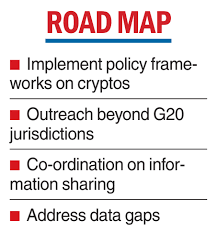
Why in the News?
Finance ministers and central bank governors (FMCBG) from G20 nations adopted a roadmap for regulating crypto assets at their meeting at Marrakesh, Morocco.
The ministers and central bank governors also decided in their joint communique to take forward key proposals from the New Delhi Leaders Declaration.
About the G20 Roadmap on Crypto Assets:
- The G20 Roadmap on Crypto Assets is a comprehensive strategy for addressing the challenges posed by cryptocurrencies.
- It focuses on regulations rather than an outright ban to prevent crypto assets from destabilising the world economy.
- It has been formulated with inputs from the International Monetary Fund (IMF) and the Financial Stability Board (FSB), both influential bodies in global finance.
Key Areas of Focus Outlined by the G20 Roadmap on Crypto Assets:
- Policy frameworks: The G20 emphasises the need for a clear and consistent policy framework for crypto assets to provide legal and regulatory clarity to businesses and investors operating in this space.
- Global coordination and cooperation: The G20 encourages international collaboration among member nations and beyond to prevent regulatory arbitrage and ensure consistent standards.
- Outreach beyond G20 jurisdictions: Recognising the global reach of crypto assets, it is essential to ensure a unified approach to crypto asset regulation, as developments in one region can impact the entire ecosystem.
- Addressing data gaps: One of the challenges in regulating crypto assets is the lack of comprehensive data. The G20 acknowledges the need to address these data gaps to ensure informed decision-making and risk assessment.
Implications of the G20 Roadmap on Crypto Assets:
- On crypto investors:
- Regulatory clarity in various jurisdictions.
- Market stability can prevent extreme price swings triggered by regulatory uncertainties.
- Mainstream adoption with mainstream financial institutions becoming more comfortable participating in the cryptocurrency space.
- On crypto businesses: Compliance requirements, Global expansion, Innovation and development, etc.
- On governments and regulators:
- Regulatory frameworks may involve amending existing laws and creating new ones, as seen with the recent trend of national digital currencies.
- Interagency coordination to ensure comprehensive oversight.
- Consumer protection from fraud and unscrupulous actors in the cryptocurrency space, avoiding another FTX-like collapse that affected innumerable people.
- On emerging markets and developing economies (EMDEs):
- Financial inclusion: Crypto assets can provide financial services to unbanked or underbanked populations in EMDEs.
- Economic development: EMDEs may explore opportunities to harness the potential of blockchain and cryptocurrencies for economic development.
- Risk mitigation: The G20 roadmap aims to help these regions strike a balance between innovation and risk management.
Highlights of the FMCBG Communique:
- This was the 4th and final G20 finance leaders meeting under the Indian presidency of G20, with the previous ones held at Washington, Bangalore and Gandhinagar.
- The communique included -
- Measures to strengthen MDBs,
- Advancement of financial inclusion through DPIs (Digital Public Infrastructure),
- Roadmap for crypto asset regulations,
- Managing global debt vulnerabilities for low-income countries,
- Financing cities of tomorrow,
- Advancing two pillar solutions on taxation for the digital economy, and
- Mobilising climate finance.
- It noted the need for transformative changes required in Multilateral Development Banks' (MDBs) operating models and financing capacities to address global challenges.
- The communique suggested an increase in MDBs’ annual spending by $3 trillion by 2030, including $1.8 trillion for additional climate action, and $1.2 trillion for achieving other SDGs.
- The communique also emphasised the importance of addressing debt vulnerabilities in low and middle-income countries in an effective, comprehensive and systematic manner.
Source: The Hindu
Asteroid Bennu
Subject: Science and Technology

Why in the News?
Recent reports show that the samples collected from the 4.5-billion-year-old asteroid Bennu could indicate the building blocks of life on Earth.
Background:-
- The sample return capsule from NASA’s OSIRIS-REx mission is seen shortly after touching down in Utah, on September 24, 2023.
- The sample was collected from the asteroid Bennu in October 2020. (NASA’s OSIRIS-REx)
About Asteroid Bennu:-
- Discovered: 1999.
- Discovered by: NASA.
- The asteroid was discovered by a team from the NASA-funded Lincoln Near-Earth Asteroid Research team in 1999.
- It was originally named as 1999 RQ36.
- The name Bennu comes from an Egyptian deity related to the Sun, often depicted as a grey heron.
- It is a 500-meter-wide asteroid in an elliptical orbit around the sun.
- It is currently more than 200 million miles from Earth.
- Bennu’s orbit is close in proximity to Earth’s, even crossing it.
- The asteroid makes its closest approach to Earth every 6 years.
- It is one of the most potentially hazardous asteroids currently known to Earth.
- It has a 1‐in‐2,700 chance of impacting Earth during one of its close approaches to Earth in the late 22nd century.
- OSIRIS-REx – short for Origins-Spectral Interpretation-Resource Identification-Security-Regolith Explorer was the first U.S. mission to collect a sample from an asteroid.
About OSIRIS-Rex:-
- Launched on: Sept. 8, 2016.
- Launched by: NASA.
- OSIRIS-REx – short for Origins-Spectral Interpretation-Resource Identification-Security-Regolith Explorer.
- It was the first U.S. mission to collect a sample from an asteroid.
- The OSIRIS-REx mission is essentially a seven-year-long voyage.
- It was meant to explore asteroid Bennu.
- The spacecraft contains five instruments including cameras, a spectrometer, and a laser altimeter.
- The spacecraft arrived at Bennu in December 2018.
- It Surveyed the asteroid for more than two years.
- Bennu is an ancient asteroid, currently more than 200 million miles from Earth.
- The asteroid was discovered by a team from the NASA-funded Lincoln Near-Earth Asteroid Research team in 1999.
- It offers scientists a window into the early solar system as it was first taking shape billions of years ago and tossing ingredients that could have helped seed life on Earth.
- On 20, 2020, the spacecraft collected a sample from the asteroid and stowed it in its sample return capsule.
- The pristine material from Bennu – rocks and dust collected from the asteroid’s surface will offer generations of scientists a window into the time when the Sun and planets were forming about 4.5 billion years ago.
Source: DTE
|
38 videos|5288 docs|1117 tests
|
FAQs on UPSC Daily Current Affairs- 14th October 2023 - Current Affairs & Hindu Analysis: Daily, Weekly & Monthly
| 1. What was the Holodomor? |  |
| 2. What is Gunji Village known for? |  |
| 3. What are the proposed reforms for the United Nations Security Council (UNSC)? |  |
| 4. What are the legal complexities and ethical dilemmas surrounding abortion rights in India? |  |
| 5. How are India and Maldives tied diplomatically? |  |





















